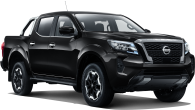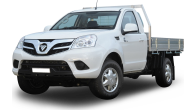Although Mitsubishi has increased prices across the board for its Triton fleet in 2021, the popular Japanese ute continues to represent excellent value for money. It also remains firmly entrenched in a solid third place in the local 4x4 ute sales race, behind the Ford Ranger and Toyota HiLux.
The previous top-of-the-range dual cab 4x4 Triton was the GLS Premium, which has been discontinued and replaced by the automatic-only 4x4 GSR variant. So, we decided to see how the second-from-top GLS measures up in an increasingly competitive market.
Mitsubishi Triton 2021: GLS (4X4)
| Engine Type | Diesel Turbo 4, 2.4L |
|---|---|
| Fuel Type | Diesel |
| Fuel Efficiency | 7.9L/100km (combined) |
| Seating | 5 |
| Price From | $33,330 - $39,710 |
| Safety Rating |
|
Price and Features – Does it represent good value for the price? What features does it come with?
Our test vehicle is available with either six-speed manual for a list price of $46,240 or six-speed automatic transmission like our example for $48,490.
It’s also equipped with several Mitsubishi genuine accessories comprising a stainless-steel front nudge bar with LED light bar (RRP$1649), tow-bar kit (RRP$1198) and polished (load tub) sports bar (RRP$1285). Combined, these add $4132, which makes our test vehicle almost the same price as the top-shelf GSR automatic at $52,740.
Even so, without these accessories the GLS offers a rich menu of standard equipment. There’s keyless entry to a nicely detailed interior with premium fabric seat trim, leather-bound steering wheel, gearshift and handbrake plus height and reach adjustable steering column. There’s also dual-zone climate control, rear privacy glass, multiple 12-volt and USB connections (including two USB ports for rear seat passengers), quality six-speaker infotainment system with 7.0-inch touchscreen, Android Auto/Apple CarPlay and more.
.jpg)
External detailing includes chrome door handles and chrome mirrors with integral heating and turn indicators, 18-inch alloys with 265/60R18 tyres and a full-size spare, side-steps, rear-step bumper, load tub liner, LED dusk-sensing headlights/DRLs with halogen fog lights, rain-sensing wipers, reversing camera and rear diff lock to name a few. It’s remarkable how much value Mitsubishi stuffs into a quality Japanese ute for less than $50K.
.jpg)
Design – is there anything interesting about its design?
The Triton’s sharp steering response and excellent agility owes much to its relatively short 3000mm wheelbase, which combined with a compact 11.8-metre turning circle and relatively narrow 1815mm width makes it easy to manoeuvre in all conditions, from tight inner-city streets and shopping centre carparks to narrow bush tracks and rugged worksites.
However, its expansive 5303mm overall length is only 123mm shorter than a Ford Ranger equivalent, even though the Triton requires a conspicuously long rear overhang to achieve it.
.jpg)
There are big grab handles on the A and B pillars to assist in climbing aboard. The Triton’s slender width is most noticeable in the cabin, which is cosy but not uncomfortable for front seat occupants as even tall adults can find comfortable seating positions. The rear seat, though, is particularly squeezy for three adults, so for any trips longer than local commutes we’d recommended a maximum of two adults in the rear stalls.
By contrast, we’re big fans of the slot-type air circulation vents in the rear roof lining. These are superior to centre console-mounted vents in directing cooling air to the faces of rear seat passengers, who also have access to their own fan-speed dial to control the level of cooling.
Engine and transmission – What are the key stats for the engine and transmission?
The 4N15 MIVEC DID intercooled four-cylinder turbo-diesel has excellent refinement, robust reliability and willing performance that belies its relatively small 2.4-litre displacement. It produces 133kW at 3500rpm and 430Nm of torque at 2500rpm, yet ample pulling power from as low as 1500rpm showcases its flexibility.
The equally refined six-speed torque converter automatic has overdriven fifth and sixth ratios for economical highway cruising and a manual shift mode using either the console shift or steering wheel paddle-shifters.
.jpg)
We also like the versatility of Mitsubishi’s Super-Select 4WD-II system, controlled by a console dial that offers a choice of high-range 2WD (2H), high-range full-time AWD (4H) which is great for icy or muddy roads, centre-diff locked (4HLc) and centre-diff locked low range (4LLc).
The 2.56:1 low-range reduction, combined with a choice of four specific off-road drive modes and a rear diff lock, makes the Triton a well-equipped and capable all-terrain vehicle.
Fuel consumption – How much fuel does it consume?
Mitsubishi claims a combined average of 8.6L/100km but the dash display was showing 9.2L when we stopped to refill the 75-litre tank after 321km of testing, which included more than a third of that distance with a near-maximum payload.
Our own figure, calculated from fuel bowser and tripmeter readings, was close at 9.4L. Needless to say, any 4x4 dual cab ute weighing two tonnes that can return single-digit economy in the real world gets a big tick from us, because in the Triton’s case you could expect a realistic driving range of almost 800km.
Practicality – How practical is the space inside?
The 900kg payload rating is what remains after you deduct the GLS's 2000kg kerb weight from its 2900kg GVM. It’s also rated to tow up to 3100kg of braked trailer and to do that you only need to reduce the maximum payload by 115kg to avoid exceeding the 5885kg GCM (or the most you can legally carry and tow at the same time). That’s a practical compromise.
The fully-lined load tub, with six anchorage points, has internal dimensions of 1520mm length, 1470mm width and 475mm depth. With 1085mm between the rear wheel housings, it will easily take a Euro 1200 x 800mm pallet but not a standard 1165mm-square Aussie pallet.
Cabin storage includes a large-bottle holder and storage bin in each front door plus a single glovebox and overhead glasses holder, while the centre console offers a small cubby at the front, two small-bottle/cup holders in the centre and a lidded box at the back which doubles as a comfortable driver’s elbow rest.
.jpg)
Rear seat passengers get a large-bottle holder but no storage bin in each door. There are also storage pouches on each front seat backrest, an open cubby in the rear of the centre console for small items and a pull-down centre armrest with two more cup holders.
.jpg)
Unlike numerous larger rivals, though, the rear seat’s base cushion is fixed with no storage space beneath it nor the ability to swing upwards and be stored vertically when more internal carry space is required. Given its relatively tight cabin dimensions, the Triton could benefit most from this versatile rear seat design.
What’s it like as a daily driver?
It’s quiet and comfortable in city and suburban driving with spirited performance thanks to its light kerb weight and ample torque. It’s easy to manoeuvre in traffic and slot into narrow parking bays.
The GLS is also a relaxed and economical highway cruiser, as the overdriven sixth gear allows the 2.4-litre turbo-diesel to lope along with only 1650rpm at 100km/h and 1800rpm at 110km/h. Engine, tyre and wind noise are also low at these speeds, allowing conversations without raised voices.
The speed-sensitive steering is responsive and nicely weighted, being light at parking speeds and increasingly firm as speeds increase, while the front disc/rear drum brakes provide strong and consistent retardation under all loads. Overall, it’s easy and pleasant to live with as a daily driver.
What’s it like for tradie use?
We forklifted 650kg into the load tub, which combined with our crew of two (170kg) and 60kg of accessories equalled a payload of 880kg, which was just 20kg under the GVM limit. The nose only rose 14mm in response to the rear leaf springs compressing 43mm. This maintained a near-level ride height with almost 60mm of rear suspension bump-stop clearance, ensuring there wasn’t a hint of bottoming-out during our test.
Given that the bulk of the heavily-loaded tub floor is behind the rear axle line, a slight pendulum effect could be felt in some tighter turns, but the Triton’s handling overall felt sure-footed and predictable with no noticeable decline in steering or braking response.
.jpg)
On our 2.0km 13 per cent gradient set climb, the six-speed auto self-shifted down to third gear at 2500rpm which was bang-on maximum torque, allowing it to easily maintain the 60km/h speed limit all the way to the top.
Engine braking on the way down, in a manually-selected second gear, was very effective at keeping speeds under the 60km/h limit, with only one brake application required on the steepest part to keep the engine a safe distance from its 4000rpm redline on overrun.
That’s outstanding engine braking for only 2.4-litres displacement, particularly given the payload it was trying to restrain, and more than competitive with larger capacity rivals we’ve tested. In other words, it punches above its weight division.
Warranty & Safety Rating
Safety – What safety equipment is fitted? What safety rating?
Maximum five-star ANCAP rating (tested 2015) with seven airbags and the latest active safety features including AEB, lane departure and blind-spot warnings, lane change assist, rear cross-traffic alert, trailer stability assist and more. There’s also ISOFIX and top-tether child seat anchorage points for the two outer rear seating positions.
Ownership – What does it cost to own? What warranty is offered?
Extensive new vehicle warranty of 10 years/200,000km plus five years perforation corrosion warranty. Scheduled servicing every 12 months/15,000km whichever occurs first. Total capped-price servicing cost of $6090 for 10 years/150,000km, or an average $609 per scheduled service.
Verdict
For under $50K, the Triton GLS represents outstanding value for money in a high quality Japanese 4x4 dual cab ute. If you compare its pricing and standard equipment with mainstream rivals, combined with excellent performance, bulletproof reliability and 10-year warranty, you’ll understand why Triton perpetually holds its ground as one of Australia’s top three 4x4 utes.
Pricing Guides

Range and Specs
| Vehicle | Specs | Price* |
|---|---|---|
| GLS (4X4) | 2.4L, Diesel, 6 SPEED AUTOMATIC | $33,220 - $39,490 |
| GLS (4X4) | 2.4L, Diesel, 6 SPEED MANUAL | $33,330 - $39,710 |
| GLX (4X2) | 2.4L, Diesel, 6 SPEED AUTOMATIC | $30,030 - $36,190 |

.jpg)
.jpg)














.jpg)

.jpg)

